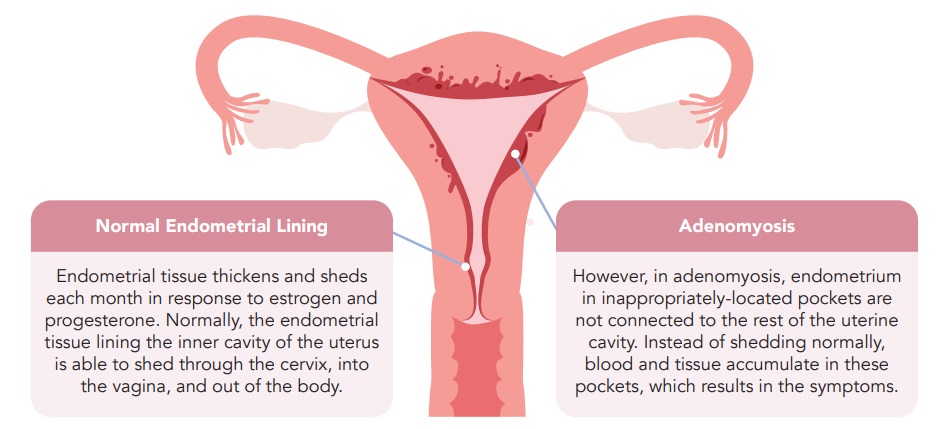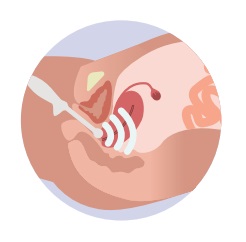Adenomyosis: General Information, Evaluation, and Treatment
Adenomyosis is a condition where the lining of the uterus, known as the “endometrium”, grows into the underlying muscular layer (the “myometrium”), and forms small pockets of endometrial tissue.

These pockets of adenomyosis are NOT cancer or pre-cancerous, and adenomyosis is a benign condition.
Symptoms of Adenomyosis
Symptoms of adenomyosis can vary from person to person, but some may include:
- Menstrual Symptoms – The most common symptoms of adenomyosis are painful periods (“dysmenorrhea”) and heavy menstrual bleeding. Adenomyosis alone does not typically not cause bleeding between periods (“intermenstrual bleeding”) or postmenopausal bleeding.
- Bulk Symptoms – Adenomyosis can cause the uterus to be enlarged and “bulky”, which may cause symptoms such as bloating.
- Fertility-Related Concerns
Diagnosis of Adenomyosis
Adenomyosis is frequently diagnosed on transvaginal/pelvic ultrasound. An adenomyotic uterus can appear larger than expected and bulky.
Often, adenomyosis can co-exist with other gynaecologic conditions and
may be coincidentally identified on imaging to investigate the presence or absence of another condition such as fibroids or endometriosis.

Treatment of Adenomyosis
Management of Symptoms
Oral Pain Medications (including Non-steroidal Anti-Inflammatory Medications/NSAIDs)
- First-line therapies can include oral pain medication such as Acetaminophen or an anti-inflammatory for pain. NSAIDs include medications such as Ibuprofen or Naproxen
Tranexamic Acid (Cyclokapron)
- Tranexamic acid (Cyclokapron) can be used on days of heavy bleeding to reduce the amount of blood flow; this is a non-hormonal treatment option.
Estrogen and Progesterone Containing Medications (Combined Hormonal)
- Medications containing both estrogen and progesterone include those such as the Oral Contraceptive Pills (OCPs), vaginal ring, transdermal patches
Progestin Only
- Intrauterine device (e.g. Mirena): significantly reduces menstrual bleeding by acting locally on the uterine cavity lining to keep it thin.
- Subdermal implant (e.g. Nexplanon): prevents pregnancy and reduces amount of
menstrual bleeding. It is implanted under the skin in the inner upper arm. - Dienogest (Visanne): causes amenorrhea (absence of menses) in almost 40% women after 6 months of use. Possible side effects include headaches, depression, irritability, nausea, and breast discomfort.
- Other forms of Progestin: Medroxyprogesterone Acetate (Depo-Provera, Provera), Norethindrone Acetate (NETA)
Gonadotropin-Releasing Hormone (GnRH) Agonists or Antagonists
- These medications cause ovaries to stop producing estrogen and progesterone, causing a reversible, medical menopause. Therefore, patients may require “add-back therapy” in the form of estrogen and progesterone, in order to maintain bone health. These types of medication include Leuprolide Acetate (Lupron) and Elagolix (Orilissa).
Definitive Management
Hysterectomy
- Definitive treatment of adenomyosis is surgical management through a hysterectomy. However, this option is not typically required and is also not appropriate for most patients (e.g. those with future plans for pregnancy).

